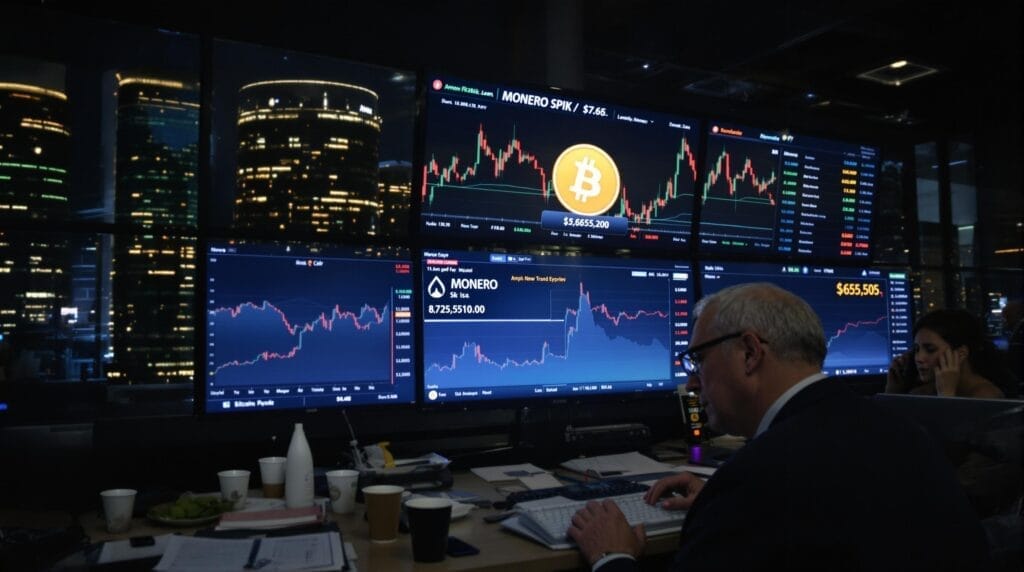Okay, so imagine someone just got their hands on a massive pile of Bitcoin. We’re talking over 3,520 coins, worth about $330 million. That’s a lot of money, right? You’d think they’d want to move it somewhere safe, somewhere quiet. And fast.
- A large amount of Bitcoin was converted to Monero, a privacy coin, raising questions about the motives behind the transaction.
- The Monero purchase caused a significant price increase, likely resulting in substantial losses for the buyer due to slippage.
- The activity in Monero derivatives markets suggests the buyer may have been attempting to profit from the price surge, indicating possible market manipulation.
What they did next was a bit odd. Instead of using something easy like Tether (a stablecoin tied to the dollar, like digital cash) or even just regular old Ethereum, they went for Monero (XMR). Monero is a privacy coin. It’s designed to make transactions hard to trace. Like trying to find a specific grain of sand on a beach.
But Monero has a catch. It’s not super easy to buy or sell huge amounts of it without messing up the price. This is called low liquidity (think of trying to sell a million rare stamps versus a million regular stamps – one is much harder). When you buy a lot of something with low liquidity, the price tends to shoot up while you’re buying. This is called slippage.
And boy, did the price shoot up. Monero jumped 45% during this big buy. Our mystery person likely lost a ton of money just on the purchase itself, maybe $66 million. That’s like dropping your wallet full of cash right after you got it.
So, why would someone lose $66 million just to get into Monero? It doesn’t make much sense if they were just trying to hide the money. There are other ways to obscure funds, even if stablecoins can sometimes get frozen by authorities. This move felt different.
This is where things get interesting, and maybe a little clever, in a not-so-nice way. While the Monero price was going wild, something else was happening. The amount of money tied up in Monero futures and options contracts – basically bets on the future price – doubled on the big exchanges.
It went from around $17 million to over $35 million. Now, a 45% price jump should have only pushed that number to about $24 million just from the price change alone. The extra $11 million? That suggests someone, or maybe a group, already had big bets placed that Monero’s price would go up. They were ‘long’ on XMR derivatives.
Think about it. They buy a massive amount of Monero on the regular market, knowing it will drive the price way up because there isn’t much for sale. Yes, they lose a bundle on that purchase due to slippage. But the price surge makes their existing bets on the price going up pay off big time.
Did the gain on the bets cover the loss from buying? Maybe not all of it, but it would certainly help soften that $66 million blow. And let’s not forget, this was likely stolen money in the first place. So, even if they lost some in the process, they’re still way, way ahead financially.
This kind of move, using a big purchase in a market that doesn’t have much supply to push the price and make money on bets elsewhere, isn’t exactly new. It’s a form of market manipulation (trying to unfairly control the price). It’s like buying up all the bread in a small town bakery just so the price of your bread futures goes up.
Just last month, someone did something similar with a token called JELLY on a decentralized exchange (an exchange that doesn’t have a central company running it). They bought JELLY where it was hard to find, which tricked the price feed the exchange used. This made people who had bet on JELLY’s price going up suddenly very happy.
These situations remind some folks of the Mango Markets hack back in 2022. In that case, a trader named Avi Eisenberg used stolen funds to mess with the price of the MNGO token. He used the inflated MNGO as collateral (something you put up to get a loan) to borrow other assets. Eisenberg was found guilty by a jury last year. He could face 20 years in prison for it.
So, while the big Monero buy might have looked like a simple attempt to hide money, the action in the derivatives market tells a different story. It looks like a calculated play. A risky one, sure, with that huge slippage loss. But maybe the plan was never just to hide the money. Maybe it was also about making a quick, extra profit on the side.
It’s a reminder that even in the world of privacy coins and hidden transactions, the financial footprints can sometimes show up in unexpected places, like the betting markets. And sometimes, the most expensive way to move money is part of a bigger, more complicated game.
Here is what blockchain watcher ZachXBT said about the transfer:
$330M BTC transferred out of wallet likely associated with a hack and converted into XMR.
https://www.coindesk.com/markets/2025/04/28/monero-price-surge-likely-attributable-to-large-hack-zachxbt
It makes you wonder what other plays are happening out there that we don’t even see. The crypto space can be a wild place, full of surprises, and sometimes, not the good kind.

